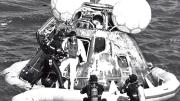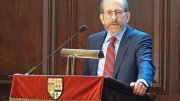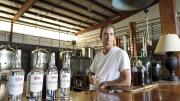The photograph is 50 years old now, a black-and-white image of two Harvard alumni meeting in the middle of the Pacific Ocean. One of them, Jonathan Smart ’69, wears a diver’s wetsuit with the hood pulled back. The other, Harrison Schmitt, Ph.D. ’64, has just returned from space. He is smiling, squinting downward in the sunlight, leaning almost casually on the open hatch of the Apollo 17 capsule from which he has emerged. Two other divers wait in a raft off to the side, as Smart, the Navy SEAL in charge of the splashdown recovery operation, helps Schmitt out of the capsule. It was December 19, 1972, and NASA’s final Apollo mission—the last time humans walked on the moon—was over.
Schmitt and his crewmates, Eugene Cernan and Ronald Evans, knew well before their launch that their mission would likely be the last of its kind (two Apollo flights scheduled to follow it were canceled after budget cuts and the near-disaster of Apollo 13 in 1970). For Schmitt, a geologist and the first—and so far only—scientist to land on the moon, this meant it was even more important to get what he’d come for: samples from the lunar surface that would help unravel deep questions about not only the origin of moon, but also the history of the Earth and the sun.
Schmitt became an astronaut almost by chance. His father was an economic geologist, and throughout college and graduate school, Schmitt figured he’d follow the same path. He came to Harvard in 1956 and spent a year in Norway on a Fulbright scholarship, researching glaciated rocks for his dissertation. That’s where he was in October 1957, when news broke of the Soviet Union’s Sputnik launch. “That certainly got my attention,” he says. After graduation, he took a job with the United States Geological Survey’s astrogeology branch; a few months later, he saw a bulletin-board notice that NASA was recruiting scientists to become astronauts. He jumped at the opportunity. Out of 1,400 applicants, he was one of six men chosen. In 1965, he began pilot training, learning to fly supersonic jets, then helicopters, and eventually the Apollo Lunar Module. Seven years later, he was on board the Apollo 17 rocket when it lifted off from Cape Canaveral on December 7, 1972, heading toward a landing site on the western face of the moon, a valley deeper than the Grand Canyon: Taurus-Littrow.
Schmitt and other NASA geologists had selected the spot because it seemed to promise material from both the ancient lunar highlands and younger volcanic activity. Largely undisturbed, it lay near a huge impact crater, surrounded by mountains “brilliantly illuminated by the sun,” he recalls, “but against a black sky. Blacker than black.” The crew returned with 254 pounds of samples, including a strange orange soil that proved to be volcanic glass from a 3-billion-year-old eruption, and a three-meter drill core whose readings indicated a major increase in the sun’s energy level 500 million years ago, which may correlate, Schmitt says, with a shift in the abundance and diversity of life in the oceans. “It’s the first time we’ve seen evidence from lunar samples relating directly to Earth,” he says. “The moon can tell us about the first 800 million years or so of Earth’s history—that’s been obscured to us because the Earth is such a dynamic cauldron of geology. But the moon has preserved it.” Earlier this year, NASA unsealed the last Apollo 17 lunar samples for analysis, ahead of the agency’s planned return to the moon in 2024 with the Artemis missions, which are intended to establish a long-term human presence there and restart scientific exploration. Schmitt, now a retired professor and former U.S. senator living in Albuquerque (but still a working scientist), is part of the University of New Mexico team studying the newly unfrozen samples.
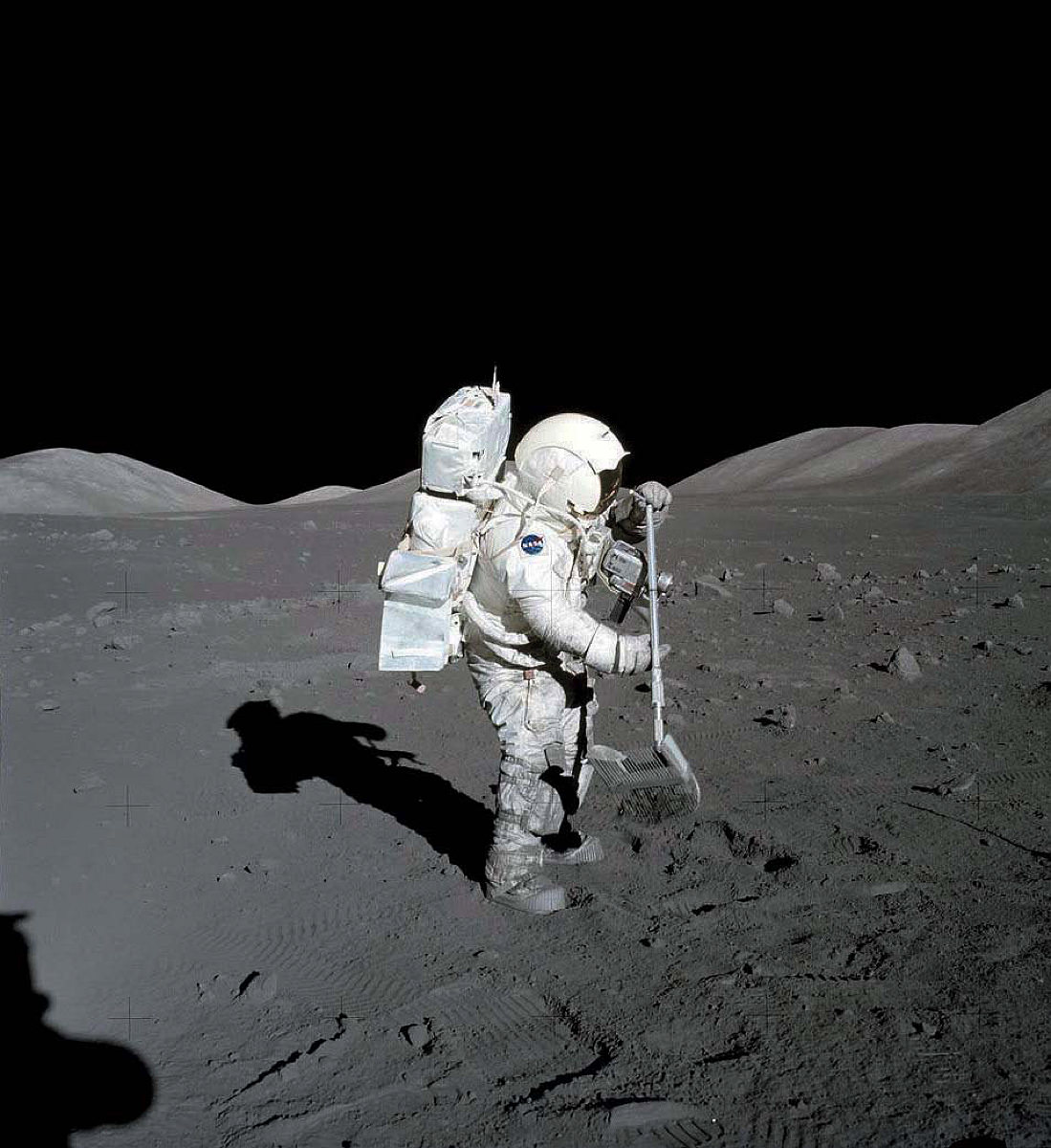
Schmitt uses a lunar rake to collect rocks and rock chips during his first of three spacewalks. Altogether, Schmitt spent 20 hours on the moon’s surface.
Photograph courtesy of NASA
When people ask him what it was like—the moon, space travel, the whole experience—he doesn’t always have the words to explain. “Hard to share,” he told one interviewer. “When the event actually takes place, it’s more than you could have imagined.” He’s described the feeling of weightlessness as “swimming with no water,” and walking on the moon as “an infinite, giant trampoline” (it was easiest, he found, to scoot along on his toes like a cross-country skier). There are evocative moments in the grainy footage of the crew’s three moonwalks: Schmitt and Cernan chattering away, giddy and amazed, as they collect rocks and sand; or speeding along in the Lunar Rover, with the passing moonscape reflected in their helmets. In one clip, Schmitt begs Mission Control to let him throw his geologist’s hammer into the sky before boarding the lander for the last time; “Look at that!” he shouts, as it goes flying end over end, wheeling into the empty distance. The mission also yielded one of the most iconic images of the space age: the “blue marble” photograph of Earth, the first to show the whole planet in one frame, fully illuminated.
Meanwhile, on the surface of that blue marble, Smart, the Navy SEAL, spent the length of the Apollo 17 mission—longer, actually—thinking about sharks and weather and the pitch of the ocean, preparing to retrieve the astronauts from their splash-landing in the Pacific. A ROTC cadet in Harvard College, Smart deployed to Vietnam seven months after graduating, the first of two tours there (he now lives in San Diego, where he became a banker after 10 years in the Navy). During a return home from Vietnam in August 1971, he’d been assigned to the recovery team for Apollo 15. “So I knew the routine,” he says. The following year, while Schmitt was gathering rocks from the lunar surface, Smart and his crew were steaming south in the USS Ticonderoga, to a spot near American Samoa, practicing daily with a simulated capsule: swimming out to attach the flotation collar that would stabilize it, coordinating with the helicopters that would carry the men to the aircraft carrier: “just giving my guys a lot of reps,” Smart says, “daytime and nighttime,” in seas both calm and rough.
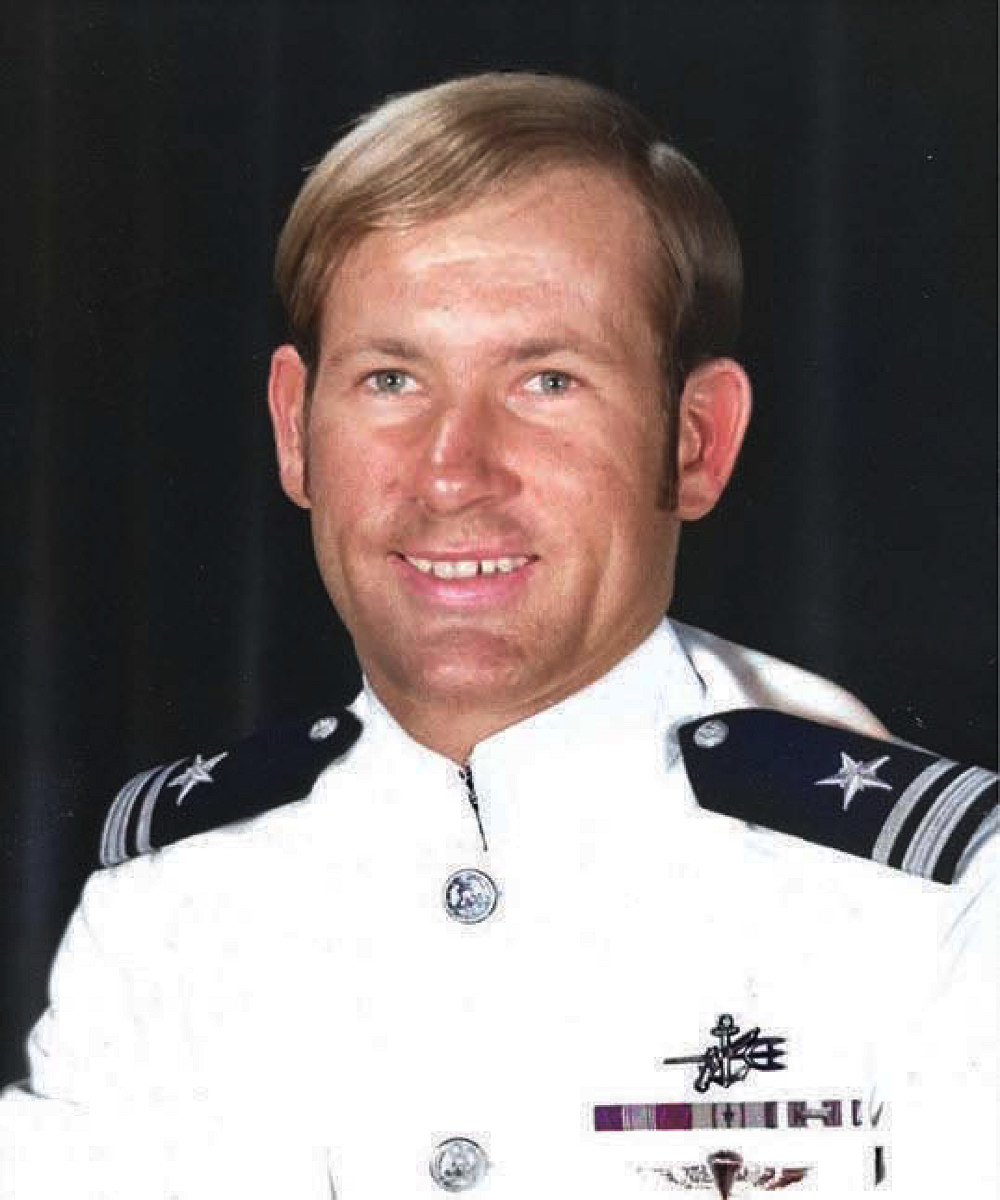
Smart led the splashdown recovery operation after returning home from Vietnam.
Courtesy of the family
It was late morning when Schmitt and his crewmates appeared in the sky, with the capsule’s parachutes inflated: “Beautiful day, gentle swells,” Smart recalls. “Textbook.” The SEALs swam out and stabilized the floating capsule. Smart opened the hatch and handed the astronauts a bag containing fresh flight suits, life vests, and three cold beers (he’d taken their drink orders at the Space Center in Houston a few weeks earlier—a tradition, much to the chagrin of NASA flight surgeons). Also in the bag were special mementos: three Navy SEAL field knives, with the blades dipped in bronze. “A gift from the team,” Smart says (Schmitt still has his, stored in a “very special place” at home).
Finally, the astronauts clambered out, Schmitt first, and then the others. Smart helped lift them, one by one, into the raft. “Welcome home,” he said.
